 Hartlepool Sports & Leisure
Hartlepool Sports & Leisure
- Cinemas, Theatres & Dance Halls
- Musicians & Bands
- At the Seaside
- Parks & Gardens
- Caravans & Camping
- Sport
 Hartlepool Transport
Hartlepool Transport
- Airfields & Aircraft
- Railways
- Buses & Commercial Vehicles
- Cars & Motorbikes
- The Ferry
- Horse drawn vehicles
 A Potted History Of Hartlepool
A Potted History Of Hartlepool
- Unidentified images
- Sources of information
- Archaeology & Ancient History
- Local Government
- Printed Notices & Papers
- Aerial Photographs
- Events, Visitors & VIPs
 Hartlepool Trade & Industry
Hartlepool Trade & Industry
- Trade Fairs
- Local businesses
- Iron & Steel
- Shops & Shopping
- Fishing industry
- Farming & Rural Landscape
- Pubs, Clubs & Hotels
 Hartlepool Health & Education
Hartlepool Health & Education
- Schools & Colleges
- Hospitals & Workhouses
- Public Health & Utilities
- Ambulance Service
- Police Services
- Fire Services
 Hartlepool People
Hartlepool People
 Hartlepool Places
Hartlepool Places
 Hartlepool at War
Hartlepool at War
 Hartlepool Ships & Shipping
Hartlepool Ships & Shipping

Heugh Lighthouse
Details about Heugh Lighthouse
The Original Lighthouse
The Heugh Lighthouse was built by Stephen Robinson, a highly regarded local civil engineer, who also designed its optical apparatus. The foundation stone was laid on August 12th, 1846, and the lighthouse was opened on October 1st, 1847, having cost the Commissioners of the Pier and Port of Hartlepool £5,750 to erect.
It was built in white sandstone, tapering from a base 24 feet in diameter, to a diameter of of 16 feet below the projecting balcony surrounding the lantern. The tower stood 58 feet high, nearly 85 feet above the high-water mark, enabling the light to be seen from a considerable distance.
There were two lights; the main light, a stationary white light (later arranged as an occulting light, dimming for one second every five seconds), and a secondary, red, tidal light, housed on a small balcony affixed to the eastern side of the tower below the main balcony. The tidal light was shown from half-flood until half-ebb and could only be seen from a distance of 4 miles. During the day, a large red ball was hoisted to the head of a mast above the lantern as a signal that ships might enter the harbour.
Both lights were illuminated by gas and were equipped with patent burners supplied and fitted by McNeill & Co. of St. Martins Lane, London. Gas was supplied by the local works of the Hartlepool Gas and Water Company, but the lighthouse was also equipped with a gas holder of its own, capable of holding up to a week’s supply in case of emergency. An oil lamp was also kept in reserve in case of breakdown.
The Temporary Light
During the First World War Hartlepool was heavily bombed by German warships, so the War Office decided to move the lighthouse, to allow the defending guns of the Hartlepool Battery a clearer line of sight. The first Heugh Lighthouse was demolished in 1915, and was replaced by a temporary light on the Town Moor.
The New Lighthouse
The temporary lighthouse was finally replaced by a new lighthouse in 1926-7. It was built near to the site of the original lighthouse, but was carefully designed to be easily taken down in an emergency – just in case the guns on the Battery were needed again!
The new lighthouse was made from white-painted cast iron, and stood 42ft high to the top of it’s dome. It was powered by electricity, and it’s light was 61,000 candlepower. The lamp was lit and extinguished automatically with a spring switch, which had to be wound up every two weeks.
Location
Related items :
 A general history of the Heugh Lighthouse
A general history of the Heugh Lighthouse
Yorkshire Gazette, Saturday, January 18th, 1845:
“New Light House at Hartlepool.— The Shipping Gazette states that the Elder Brethren of the Trinity Board, in answer to the memorial of the owners and masters of vessels and other persons interested in the commerce of the port of Hartlepool, soliciting that light-house may be established on the Heugh at that place, concur with the memorialists in the opinion that a light-house may be advantageously placed upon Hartlepool Heugh; and that they are "ready to take the necessary measures for erecting such light-house, and maintaining a light thereon during the night season, provided the trade of the port shall consent to pay such toll on all vessels entering the port or departing therefrom as shall be requisite to defray the expense such light house and light." This the trade of the port are willing to do, as expressed in their memorial, but while willing to bear the whole burden, they are, of course, desirous to have it as light as possible. It will be trifling, considering the benefit that will be derived thereby. On this point alone there is a slight difference of opinion between the memorialists and the Trinity Board.”
Durham Chronicle, Friday, May 5th, 1846:
“TO MASONS. TO BE LET BY PROPOSAL, THE BUILDING of a TOWER for a lighthouse upon the Heugh, or Headland, at Hartlepool.
A Plan and Specification may be seen on application to Mr. ROBINSON, Engineer, Hartlepool, after the 18th inst. and sealed tenders addressed to the Commissioners of the Pier and Port of Hartlepool will be received until WEDNESDAY, the 27th May, inst.
N.B. The Commissioners not bind themselves to accept the lowest tender. Hartlepool, 14th May, 1846.”
Newcastle Journal, Saturday, August 15th, 1846:
“HARTLEPOOL NEW LIGHTHOUSE. On Wednesday last, Thomas Rowell, Esq. Mayor of Hartlepool, preceded by the macebearers, and followed several aldermen. Mr. Mackenzie, collector of her Majesty's Customs, Lieutenant Strover, of the Preventive Service, and a number of merchants, proceeded from the Town Hall to the site of the intended erection, the south-east corner of the Hartlepool Heugh, and there laid the foundation stone, after which his worship delivered a short and appropriate address to a large concourse of townsmen assembled to witness the interesting ceremony. The whole was concluded by a suitable prayer offered the Rev. Robert Hamilton, curate of St. Hilda’s Church.”
Newcastle Journal, Saturday, August 28th, 1847:
“NOTICE TO MARINERS. LIGHTHOUSE ON HARTLEPOOL HEUGH.
Latitude 54° 41’ 51” North
Longitude 1° 10’ 19” West of Greenwich
THE Commissioners of the Pier and Port of Hartlepool hereby give Notice, that, acting under the Sanction of the Corporation of Trinity House, London, they have erected, in Connection with the Purposes of the said Pier, and for the general Advantage of the Port, a Lighthouse on the Heugh or Headland at Hartlepool, in the County of Durham, from which a FIXED WHITE LIGHT will be exhibited on the Evening of the 1st October, 1847, and continued every Night from Sunset to Sunrise.
The Light will bear by Compass from Souter Point, on the coast of Durham, S½W distant 17 Sea Miles, and from Staiths Old Nab on the Yorkshire Coast, N.W. by N. distant 16½ Sea Miles; and will be seen at any Place along the coast within these Points , and Seaward during Clear Weather at a Distance of 15 Miles, the Light being of the First Order, and at an Elevation of 84 Feet above the level of High Water Spring Tides.
There will also be exhibited from the same Tower at Night (underneath the principal Light), from Half-flood to Half-ebb, a TIDAL LIGHT of a RED Colour; and during the Day, at Half-flood, RED BALL will be hoisted to the Top of a Mast on the Tower, where it will remain until Half-ebb.
The Lights will be free of any Charge whatever to the Trade.
The Stationary Light on the Pier Head of the Old Harbour will be shown as heretofore; but the Tide Light in connection therewith, will, after the 30th September next, be discontinued.
The FIXED GREEN LIGHT which, under the like Sanction, has been shown on each Pier of the WEST HARBOUR from Sunset to Sunrise, and also the TWO RED LIGHTS which have been exhibited in one, bearing N.W. as Leading TIDE LIGHTS into the West Harbour, will be continued as before. – By Order, W. Davison, Clerk.
Hartlepool, August 2nd, 1847.”
Newcastle Guardian and Tyne Mercury, Saturday, October 16th, 1847:
“HARTLEPOOL HEUGH LIGHTHOUSE. This important and praiseworthy undertaking has been completed, and was lighted for the first time on the 1st inst. It is shown at an elevation of about 84 feet above the level of high water spring tides, from handsome tower of dressed freestone, the frame work of the lantern being of cast iron, darkened by plates of the same material from WSW to N¼W on the landward side. The power of the light is ascertained from the fact that it can be seen with great distinctness distance of 18 miles. We congratulate all connected with the shipping interest on the completion of this much needed structure, for it will, doubtless, prevent serious destruction of property, and save many a hardy tar from a watery grave.
We observe, from the columns of a contemporary, that the first exhibition of the new light was celebrated by a supper at the King's Head Hotel. The entertainment, we are told, was "sumptuous," and there appears to have been met a jovial and merry party, for they gave more toasts and delivered more speeches than the reporter is able to record, and did not go home till morning. Compliments were plentiful as blackberries. Each man toasted his neighbour, and the company exercised their lungs lustily with three times three and one cheer more; yet, amidst all this exuberance of praise, we regret to find strange and unaccountable omission. Of course the public boards in the town were duly honoured, and even the engineer and haven master were not forgotten; yet (will it be believed!) the little party at the King's Head, although they did not separate until long after the " witching hour," never found opportunity of drinking the health and recognizing the services of the man to whose indefatigable labours and incomparable zeal Hartlepool especially, and the shipping interest in general, are indebted for this useful lighthouse. Never was stronger illustration given of Hamlet being played, with the part of the Prince of Denmark omitted! Whether this was done from accident or by design, we have no means of judging. We are unwilling to conclude that the supper party were actuated by contemptible feelings of jealousy and envy, and studiously committed the injustice of suppressing all reference to the gentleman whose health ought to have formed the chief topic of the evening; and yet, how are we to believe that Messrs Denton, Rowell, Belk, and Vollum, forgot the debt of gratitude under which the town is laid to Mr. Lindsay for this great boon Why, the men who now take all the credit to themselves in this matter, were the very parties who were at the outset its strongest opponents. Mr. Belk and Mr. Rowell petitioned against it, Mr. Denton refused to sign the memorial in its favour, the Hartlepool Dock and Railway Company would not move in the business, and it was principally owing to the services rendered by Mr. Lindsay—to his strenuous and public spirited efforts both in Hartlepool and with the Trinity Board in London, that the result has been accomplished.
In reading the report to which we have referred, we observe that one speaker, Mr. Mackenzie, remarked that "although the brilliant object on the Heugh would from that night forth be favourably and emphatically known as the Hartlepool light, still there was one name which would ever be honorably associated with it, that of - it should have been Mr. W.S. Lindsay, but by an unaccountable erratum, Mr. Stephen Robinson is substituted. Mr. Robinson was the engineer, and no doubt did his work well. But he is not entitled to all this honor. His friends should have remembered that "praise undeserved is censure in disguise," and carefully avoided this mal-appropriation of credit which belongs to another, though absent, man.
We refrain from adverting to the services rendered by Mr. Lindsay to the port in other respects—to his unwearied and successful labours in favor of Hartlepool being made an independent port, and enjoying the privilege of a post office, and to what he has done the way of sending large-sized vessels to load there for the East Indies and elsewhere. We may recur to the subject, if any of our statements are controverted. At present, we are only anxious to strip certain parties of the plumage which does not belong to them. This is necessary, not for the sake of the inhabitants of Hartlepool who know well their true benefactors, but for the sake of the public at a distance who are liable to deception, and in order that honor may be given to whom honor is due.”
Illustrated London News, Saturday, November 6th, 1847:
“HARTLEPOOL LIGHTHOUSE. This new Light, at Hartlepool, Durham, was first exhibited about month since. It occupies a prominent position upon the eastern extremity of the peninsula, jutting out into the sea, a few miles from the Tees’ mouth, and upon which is built the town of Hartlepool.
The Lighthouse is a handsome structure of white freestone—the building itself being fifty feet in height; but, owing to the additional height of the cliff, the Light is exhibited at an elevation of nearly eighty-five feet above high-water mark. On the eastern side of the building is placed a balcony, supporting lantern, from which a small red light is exhibited, to indicate that state of the tide which will admit of the entrance of ships into the harbour; the corresponding signal in the day-time being a red ball hoisted to the top of the flag-staff. The Lighthouse is furnished with an anemometer and tidal gauge; and its appointments are altogether of the most complete description. It is chiefly, however, with regard to the system adopted in the lighting arrangements that novelty presents itself.
The main object in the instance of a light placed as a beacon to warn mariners of their proximity to a dangerous coast, is to obtain the greatest possible intensity and amount of penetrating power. A naked or simple light is, therefore, seldom, if ever, employed; but whether it proceed from the combustion of oil or gas, it is equally necessary that it should be combined with some arrangement of optical apparatus, in order that the rays emitted may be collected, and projected in such direction to render them available to the object in view. The apparatus employed in light-houses is of two descriptions, Catoptric and Dioptric. In the former, the rays are received upon a surface of highly polished metal, from which they are reflected; the parabolic curve is generally adopted for such reflectors; and, the light is placed at the focus of the parabola, the rays are projected in a parallel sense, and render the form of a cylinder of intense light, the diameter of the cylinder depending upon the size of the reflector employed. In the Dioptric system, the rays are transmitted through an arrangement of lenses and glass zones, by the refractive power of which they are projected parallel with respect to their vertical sense; but diverging horizontally, so that, instead of the luminous cylinder obtained by means of the parabolic reflector, an illuminated zone or belt of light is produced. In the Hartlepool Lighthouse, both these systems have, to a certain extent, been adopted, and the illuminative medium is gas. The optical apparatus embraces three-fourths of the circumference of the circle which encloses the light, and the whole of the rays emanating from that part of the light opposed to the optical arrangement are reflected or refracted (as the case may be), so that they are projected from the Lighthouse in such a direction as to be visible from the surface of the ocean.
The application of gas to the illumination of Lighthouses has always been regarded an important and desirable step. Mr. Stevenson, in evidence before Committee of the House of Commons, remarked that the great desideratum with respect to the lighting of Lighthouses, was a gas-burner of large size, and that it was in that direction that improvement was to be sought.” Hitherto, however, no gas-burner has been constructed, capable of furnishing the necessary amount of light, combined with the steadiness, intensity, and solidity of flame requisite render its application advantageous as a substitute for the oil lamp.
As a means of illumination, gas possesses numerous advantages over oil; and under no circumstances are those advantages more strongly displayed than in the case of a Lighthouse, where simplicity in the machinery, facility of management, and certainty of effect, are objects of the greatest importance.
The gas-burner employed in this present instance, appears to supply that which has so long been wanting: it is constructed on the most philosophical principle, its chief peculiarity lying in the method employed to supply the air necessary to the perfect combustion of the gas. This supply is not only regulated with great exactness, but all the parts by which the air passes are placed on such angles that the impinging air is reflected and forced directly into the flame at the precise point in which it will conduce most powerfully to support the combustion. At the same time, the requisite quantity only is admitted; and therefore the flame is perfectly steady, and not, it is technically termed, distressed and driven into spires by too powerful and rapid a current of air. The inverted cone placed in the centre, is hollow, and the air which is admitted by the tube which supports it, issues into the flame by a row of holes placed round the periphery of its base. By these contrivances, the burner is made to produce a rich opaque mass of flame, affording a powerful and steady light; and, when placed in the centre of the optical arrangement of lenses, lenticular zones, and mirrors, an immense amount of intense light is spread over the horizon.
In the instance now before us, the capability of gas to produce a light sufficiently powerful, was satisfactorily proved; for, in some cases, it was distinctly seen on board ships at least eighteen miles distant from the coast; the gas, on this occasion, was used in its ordinary condition; but, in future, it is proposed to napthalise the gas, and, in that case, the power of the light will be increased by at least twenty per cent.
The Lighthouse was built and the optical apparatus planned by Mr. Stephen Robinson, Civil Engineer, Hartlepool. The burner is that patented by Messrs. McNiell and Co., 60, St. Martin’s-lane, who fitted up those employed in the Lighthouse, and all the arrangements for lighting with gas.”
 Bonfire on the Town Moor
Bonfire on the Town Moor
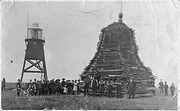 Donated by John Dee
Donated by John DeeThis impressive bonfire was built to celebrate the end of the First World War. Alongside it is the temporary lighthouse. The original lighthouse on the Headland was demolished as it got in the way of the guns from the Heugh Battery. The temporary lighhouse was constructed on the Town Moor, where is stood from 1915 until it was replaced by the current structure in 1926.
More detail » Boys Brigade at the seaside
Boys Brigade at the seaside
 Donated by Hartlepool Museum Service
Donated by Hartlepool Museum ServiceGroup of twelve Boys Brigade members on Hartlepool Promenade with the lookout and lighthouse in the background.
More detail » Cliff Terrace and Lighthouse
Cliff Terrace and Lighthouse
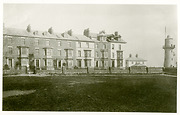 Donated by Hartlepool Museum Service
Donated by Hartlepool Museum ServiceThis picture shows houses in Cliff Terrace and the original lighthouse, which was removed by 1915. The house on the right was the home of the Misses Kay, who were killed and the house demolished during the Bombardment of the town on 16th December 1914.
One of the houses on the left was once owned by Thomas Richardson, who built the first Hartlepool ship "Castle Eden". The playground in foreground is now the Memorial Gardens.
More detail » Hartlepool Lighthouse
Hartlepool Lighthouse
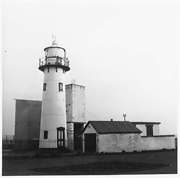 Donated by Douglas Ferriday
Donated by Douglas FerridayPart of the Hartlepool Library Service collection
Dated 1970
The current lighthouse at the Heugh, in old Hartlepool.
More detail » Heugh Lighthouse
Heugh Lighthouse
 Created by Francis Elsdon
Donated by Hartlepool Museum Service
Created by Francis Elsdon
Donated by Hartlepool Museum ServicePart of the Elsdon Collection collection
Dated 1988
Heugh Lighthouse in 1988.
More detail » Heugh Lighthouse - Hartlepool (1)
Heugh Lighthouse - Hartlepool (1)
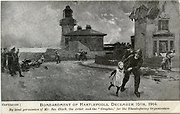 Created by The Graphic
Donated by Mr. John Davies
Created by The Graphic
Donated by Mr. John DaviesDated 1914
An image of the the Heugh Lighthouse during the Bombardment.
More detail » Heugh Lighthouse and Battery
Heugh Lighthouse and Battery
 Created by unknown
Donated by Rosa Simon
Created by unknown
Donated by Rosa SimonDated 1952
A view of the Heugh Lighthouse and Battery taken from the New Pier in 1952.
More detail » Lighthouse
Lighthouse
 Donated by Hartlepool Museum Service
Donated by Hartlepool Museum ServiceThe lighthouse before the new sea wall was built.
More detail » Lighthouse at old Hartlepool - c1890
Lighthouse at old Hartlepool - c1890
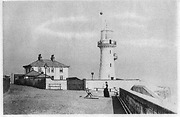 Donated by Maureen Anderson
Donated by Maureen AndersonThe lighthouse in about 1890. The house, where two sisters lived, was badly damaged by bombing in WW1.
More detail » Lighthouse from Heugh Breakwater
Lighthouse from Heugh Breakwater
 Donated by Hartlepool Museum Service
Donated by Hartlepool Museum ServiceA picture of the lighthouse and surrounding streets, taken from the Heugh breakwater.
More detail » Lighthouse from the Heugh Breakwater
Lighthouse from the Heugh Breakwater
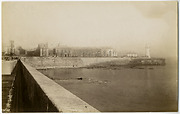 Donated by Hartlepool Museum Service
Donated by Hartlepool Museum ServiceLighthouse from the Heugh Breakwater. Also, the breakwater seems to be getting repaired at this time. There is a crane like structure at the end with new blocks lined up on the pier. The crane is secured by wired secured on the beach to the right.
More detail » Old Hartlepool Lighthouse c1903
Old Hartlepool Lighthouse c1903
 Donated by Douglas Ferriday
Donated by Douglas FerridayPart of the Hartlepool Library Service collection
Old Hartlepool Lighthouse c1903
More detail » Old Hartlepool from the air
Old Hartlepool from the air
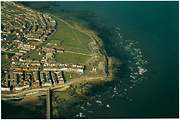 Donated by Hartlepool Library Service
Donated by Hartlepool Library ServiceOld Hartlepool from the air. The Heugh Breakwater can be seen along with the lighthouse. the town moor and the war memorial.
More detail » Pilot Pier Lighthouse
Pilot Pier Lighthouse
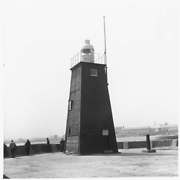 Donated by Douglas Ferriday
Donated by Douglas FerridayPart of the Hartlepool Library Service collection
A view of the lighthouse on the Pilot Pier, with men fishing from the pier end. The picture was probably taken in the 1970s.
More detail » Redheugh Gardens and lighthouse
Redheugh Gardens and lighthouse
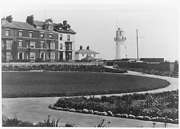 Donated by Douglas Ferriday
Donated by Douglas FerridayPart of the Hartlepool Library Service collection
Dated 1914
Redheugh Gardens, showing Cliff Terrace and the original Heugh Lighthouse circa 1914.
More detail » Scouts on visit to Lighthouse
Scouts on visit to Lighthouse
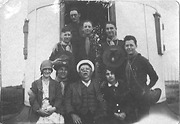 Donated by John Dee
Donated by John DeePicture depicting boy scouts visiting the Lighthouse in Hartlepool. Lighthouse keeper in the centre of the picture.
More detail » The Lighthouse
The Lighthouse
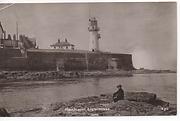 Donated by Mike Oxley
Donated by Mike OxleyLighthouse, Hartlepool Headland taken from a postcard around 100 years old.
More detail » The lighthouse 1935
The lighthouse 1935
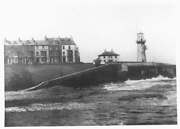 Donated by Douglas Ferriday
Donated by Douglas FerridayPart of the Hartlepool Library Service collection
Picture of the lighthouse from 1935
More detail » Town Moor and Bandstand
Town Moor and Bandstand
 Donated by Hartlepool Museum Service
Donated by Hartlepool Museum ServiceThe Town Moor and The Bandstand on the Promenade at Old Hartlepool. The temporary lighthouse can be seen on the Moor which put this picture c1920.
More detail »



